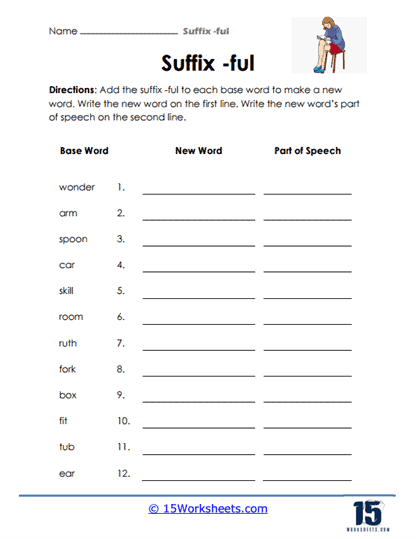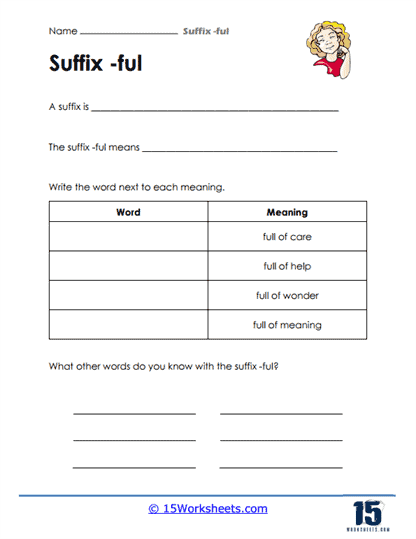Suffix -ful Worksheets
About These 15 Worksheets
These worksheets will enhance students’ understanding and application of the suffix “-ful” in English. The suffix “-ful” is attached to nouns to form adjectives, suggesting that something has the attributes of or is full of the noun it is derived from. For instance, “beauty” becomes “beautiful,” implying full of beauty. These worksheets are structured to reinforce vocabulary, spelling, and grammatical skills by offering a variety of exercises tailored to different learning styles and proficiency levels. Delving into the types of exercises found in these worksheets and their educational benefits can provide insight into their role in fostering language proficiency.
From enhancing vocabulary and understanding word formation to fostering grammatical proficiency and encouraging creative expression, these worksheets offer a holistic approach to language mastery. By engaging with these exercises, students not only memorize the use of the suffix “-ful” but also develop a keen understanding of its functional role in English, laying a solid foundation for proficient and expressive communication.
Types of Exercises in Suffix -ful Worksheets
Word Matching Exercises
In these exercises, students match words with the suffix “-ful” to their definitions or pictures representing their meanings. This activity helps in vocabulary building and understanding the contextual usage of these adjectives. These exercises require students to complete sentences with the correct “-ful” word. It enhances their ability to use these adjectives appropriately in a sentence, reinforcing grammar and contextual understanding.
Sentence Construction
Students construct sentences from given “-ful” words. This not only tests their understanding of the word’s meaning but also encourages creative sentence formation, improving their writing skills. These tasks involve adding “-ful” to base words to form new adjectives. It’s a straightforward exercise that strengthens spelling skills and helps students understand how words can transform from nouns to adjectives.
Some worksheets introduce other suffixes or prefixes alongside “-ful” to compare and contrast. These exercises broaden students’ understanding of how different affixes alter the meanings of base words.
Error Corrections
Worksheets may present sentences with incorrect usage of “-ful” words, prompting students to identify and correct the mistakes. This exercise develops editing skills and an eye for detail, crucial for good writing. Identifying synonyms and antonyms of “-ful” adjectives enhances understanding of nuances in meaning, an essential skill for sophisticated language use.
How These Worksheets Help Students
Enhanced Vocabulary through Suffix -ful Worksheets
The consistent use of suffix -ful worksheets plays a pivotal role in broadening students’ linguistic horizons. By regularly engaging with these exercises, learners significantly expand their collection of adjectives, empowering them to articulate thoughts and ideas with greater precision and color. This enhancement in vocabulary is not just about adding words; it’s about enriching the entire communicative experience. A well-developed vocabulary is the cornerstone of effective communication, allowing students to convey their thoughts in ways that are not only clear but also compelling and nuanced. Expressive writing, a skill highly valued across academic and professional domains, flourishes when students have a rich bank of words at their disposal. Thus, these worksheets do more than just teach; they equip students with the lexical tools to thrive in any communicative context.
Improved Spelling and Word Formation Skills
Delving into the mechanics of word formation, particularly through the use of suffixes, is fundamental for mastering spelling and understanding the dynamic nature of the English language. Suffix -ful worksheets provide a structured approach to learning how suffixes modify base words, highlighting the transformative power of these linguistic elements. Through repeated practice, students become familiar with the patterns and rules that govern word formation in English. This knowledge is crucial, not only for spelling accuracy but also for understanding the nuanced shifts in meaning that affixes can induce. By dissecting words and analyzing their components, students develop a keen eye for spelling and a profound appreciation of word architecture, skills that are indispensable in both academic and everyday writing.
Grammatical Proficiency through Contextual Learning
The exercises in suffix -ful worksheets are meticulously designed to encourage learners to engage with grammatical structures and word agreements actively. When students are tasked with completing or constructing sentences using “-ful” adjectives, they are not just filling blanks or constructing phrases; they are delving into the heart of English syntax. This process fosters a natural and intuitive understanding of grammatical rules, going beyond rote memorization. By consistently practicing with these worksheets, students develop an innate sense of how words fit together in sentences, leading to a fluent and confident use of language that is both grammatically sound and stylistically polished.
Deepening Contextual Understanding and Usage
The journey of learning with suffix -ful worksheets extends into the realms of context and application. These exercises are not confined to teaching the meanings of words in isolation. Instead, they immerse students in scenarios where “-ful” adjectives are used in sentences, matched with definitions, or associated with images. This immersive approach ensures that learners grasp not just the dictionary definitions of words but also their practical, contextual applications. Understanding how to use words appropriately in various contexts is a skill of paramount importance, one that enhances both comprehension and the ability to craft impactful, meaningful text. It’s a skill that stands at the core of not just academic success but effective communication in daily life.
Cultivating Critical Thinking and Editing Skills
Error correction exercises embedded in these worksheets are a goldmine for developing critical thinking and meticulous editing skills. When students engage in identifying and rectifying mistakes, they are not just learning about correct usage. They are sharpening their analytical skills, training their minds to spot inconsistencies and errors in sentence construction and content. This ability to critically assess and improve text is invaluable, transforming students into proficient editors of their own and others’ work. These skills are indispensable, paving the way for excellence in academic writing and fostering clear, effective communication in everyday interactions.
Fostering Engagement and Retention
The diverse array of exercises in suffix -ful worksheets ensures that learning never becomes monotonous. Whether it’s through interactive puzzles, matching games, or creative writing prompts, these worksheets are designed to capture and maintain students’ interest. This variety caters to different learning styles, ensuring that every student finds an approach that resonates with them. More importantly, this diversity in teaching methods enhances retention. When students are actively engaged, they are more likely to absorb and remember the material, making these worksheets an effective tool for long-term learning.
Enhancing Creative Writing Skills
Encouraging students to form sentences and weave stories using “-ful” adjectives does more than just reinforce their understanding of these words; it ignites their creativity. When learners are prompted to use descriptive and expressive adjectives in their writing, they begin to see language as a rich tapestry of possibilities. They learn to convey complex emotions, depict vivid scenarios, and articulate intricate thoughts more effectively. This creative empowerment is one of the most profound benefits of these worksheets, fostering a style of writing that is not just correct but also captivating and original.
Encouraging Comparative Language Analysis
The inclusion of exercises that juxtapose the suffix “-ful” with other suffixes or prefixes transforms these worksheets into a powerful tool for comparative language analysis. By engaging in these comparison exercises, students develop a deeper understanding of English morphology. They learn to analyze language structures critically, understanding not just how words are formed but also how subtle changes in suffixes or prefixes can alter meanings. This analytical approach to language fosters a comprehensive understanding of English, equipping students with the skills to decode and appreciate the richness and complexity of the language.
The Spelling Rule For The Suffix -ful
The spelling rule for words ending in “-ful” involves adding the suffix “-ful” to the end of a root word to create an adjective that means “full of” or “characterized by.” However, there are some rules and changes to consider when applying this suffix to certain root words. Here are three examples of how the root words are changed:
Example 1: Hope + ful = Hopeful
In this case, the root word is “hope,” and the suffix “-ful” is added to it. The “e” at the end of “hope” is dropped before adding the suffix, resulting in “hopeful.” This change occurs because when a root word ends in “e,” you usually drop the “e” before adding the suffix to maintain correct spelling and pronunciation.
Example 2: Care + ful = Careful
The root word is “care,” and the suffix “-ful” is added to it. No changes are needed in this example because the root word “care” does not end in a vowel followed by a single consonant. When a root word doesn’t end in “e” or have a vowel-consonant pattern, you can directly add “-ful” without any alterations.
Example 3: Use + ful = Useful
Here, the root word is “use,” and the suffix “-ful” is attached. Like in the first example, the final “e” in “use” is dropped before adding the suffix. This is done to maintain consistent spelling rules and pronunciation.
In summary, when adding the suffix “-ful” to a root word:
- If the root word ends in “e,” drop the “e” before adding “-ful.”
- If the root word doesn’t end in “e” and doesn’t have a vowel followed by a single consonant pattern, you can directly add “-ful” without changes.















